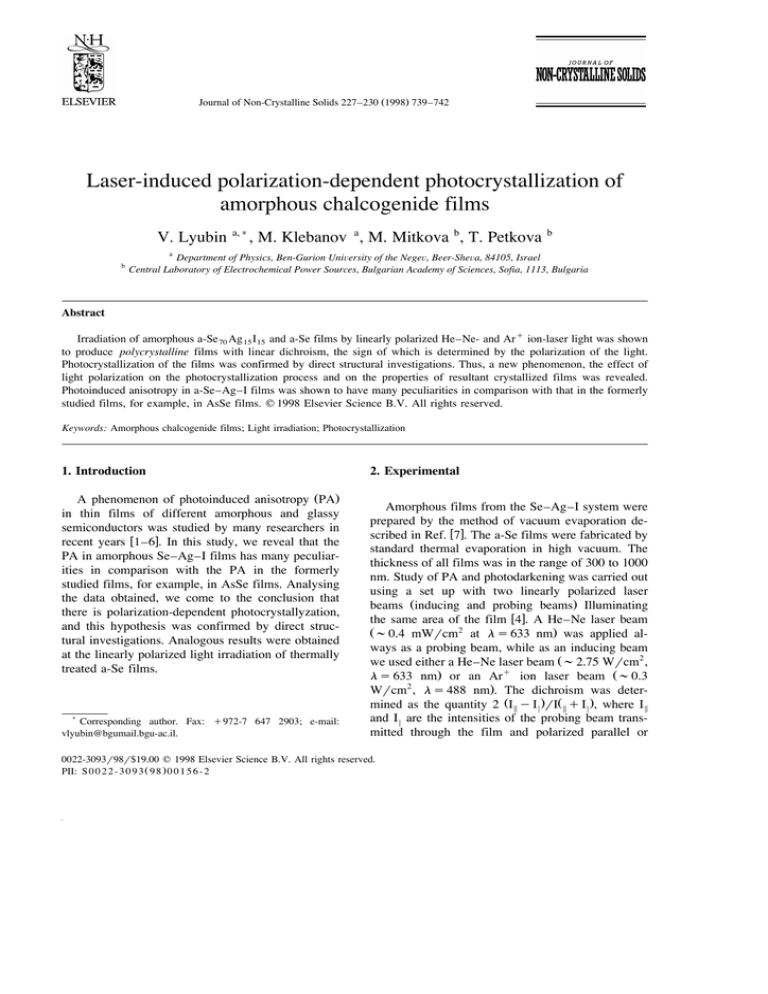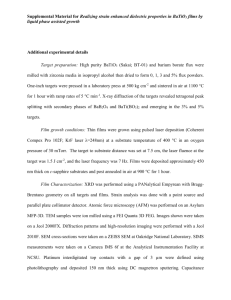
Journal of Non-Crystalline Solids 227–230 Ž1998. 739–742
Laser-induced polarization-dependent photocrystallization of
amorphous chalcogenide films
V. Lyubin
b
a,)
, M. Klebanov a , M. Mitkova b, T. Petkova
b
a
Department of Physics, Ben-Gurion UniÕersity of the NegeÕ, Beer-SheÕa, 84105, Israel
Central Laboratory of Electrochemical Power Sources, Bulgarian Academy of Sciences, Sofia, 1113, Bulgaria
Abstract
Irradiation of amorphous a-Se 70 Ag 15 I 15 and a-Se films by linearly polarized He–Ne- and Arq ion-laser light was shown
to produce polycrystalline films with linear dichroism, the sign of which is determined by the polarization of the light.
Photocrystallization of the films was confirmed by direct structural investigations. Thus, a new phenomenon, the effect of
light polarization on the photocrystallization process and on the properties of resultant crystallized films was revealed.
Photoinduced anisotropy in a-Se–Ag–I films was shown to have many peculiarities in comparison with that in the formerly
studied films, for example, in AsSe films. q 1998 Elsevier Science B.V. All rights reserved.
Keywords: Amorphous chalcogenide films; Light irradiation; Photocrystallization
1. Introduction
A phenomenon of photoinduced anisotropy ŽPA.
in thin films of different amorphous and glassy
semiconductors was studied by many researchers in
recent years w1–6x. In this study, we reveal that the
PA in amorphous Se–Ag–I films has many peculiarities in comparison with the PA in the formerly
studied films, for example, in AsSe films. Analysing
the data obtained, we come to the conclusion that
there is polarization-dependent photocrystallyzation,
and this hypothesis was confirmed by direct structural investigations. Analogous results were obtained
at the linearly polarized light irradiation of thermally
treated a-Se films.
)
Corresponding author. Fax: q972-7 647 2903; e-mail:
vlyubin@bgumail.bgu-ac.il.
2. Experimental
Amorphous films from the Se–Ag–I system were
prepared by the method of vacuum evaporation described in Ref. w7x. The a-Se films were fabricated by
standard thermal evaporation in high vacuum. The
thickness of all films was in the range of 300 to 1000
nm. Study of PA and photodarkening was carried out
using a set up with two linearly polarized laser
beams Žinducing and probing beams. Illuminating
the same area of the film w4x. A He–Ne laser beam
Ž; 0.4 mWrcm2 at l s 633 nm. was applied always as a probing beam, while as an inducing beam
we used either a He–Ne laser beam Ž; 2.75 Wrcm2 ,
l s 633 nm. or an Arq ion laser beam Ž; 0.3
Wrcm2 , l s 488 nm.. The dichroism was determined as the quantity 2 ŽI 5 y I < .rIŽ 5 q I < ., where I 5
and I < are the intensities of the probing beam transmitted through the film and polarized parallel or
0022-3093r98r$19.00 q 1998 Elsevier Science B.V. All rights reserved.
PII: S 0 0 2 2 - 3 0 9 3 Ž 9 8 . 0 0 1 5 6 - 2
740
V. Lyubin et al.r Journal of Non-Crystalline Solids 227–230 (1998) 739–742
perpendicular to the electric vector of the inducing
beam.
3. Results
As-prepared Se–Ag–I films did not photodarken
under the action of either He–Ne or Arq ion laser
light but displayed the PA with properties analogous
to that in the films of As–Se, As–S and others
studied previously w1,4,5x. Such behaviour is demonstrated in Fig. 1 and Fig. 2a. At the same time,
storage or the films at temperature of ; 358C during
2 weeks of their artificial aging Žannealing at 708C
for 2 h. resulted in a detectable change of photoinduced processes in them. Strong and prolonged photodarkening appeared during irradiation at room temperature ŽFig. 1.. In the treated film, a photoinduced
dichroism ŽPD. was observed and a change of the
polarization vector to orthogonal one resulted in the
reorientation of the PD that was characterized by the
constant change of reorientation kinetics and by following alteration of the dichroism sign ŽFig. 2b.. If
at the beginning of the experiment the vertical polarization vector stimulated increase of positive dichroism while the horizontal polarization vector diminished positive dichroism and led to negative dichroism, in the following stages the reverse processes
were observed.
Fig. 1. Kinetics of transmission changes in as-prepared and thermally treated Se 70 Ag 15 I 15 film stimulated by linearly polarized
He–Ne and Arq laser light. The lines are drawn as guide for the
eyes.
Fig. 2. Kinetics of dichroism generation and reorientation in
as-prepared Ža. and thermally treated Žb. Se 70 Ag 15 I 15 film stimulated by linearly polarized He–Ne laser light with horizontal Ž x .
and vertical Ž y . directions of the electrical vector. The lines are
drawn as guide for the eyes.
The PD excited by the He–Ne laser light at
constant direction of polarization vector changed the
sign very soon and grew slowly, achieving ; 18%
as shown in Fig. 3a. The light induced dichroism
obtained by irradiation with an Arq ion laser followed similar dependence but the saturated dichroism was less and was achieved in less time ŽFig. 3b..
The sign of the final dichroism was determined by
the direction of the exciting light polarization vector.
Some relaxation of PD with time was observed for
the early periods and was not observed in final
stages as can be seen from Fig. 3a. Annealing of
irradiated Žphotodarkened. films at glass transition
V. Lyubin et al.r Journal of Non-Crystalline Solids 227–230 (1998) 739–742
741
results Žphotodarkening at room temperature, opposite sign and larger PD, absence of relaxation and
thermal erasing. permitted us to assume that there is
one photoinduced photocrystallization ŽPC. process
w8,9x.
This assumption was confirmed by the direct
structural investigations including optical microscopy, electron microscopy and X-ray diffraction
study. In Fig. 4, the results of scanning electron
microscope investigation of Se 70 Ag 15 I 15 films are
demonstrated. Initially, homogeneous films with an
uniform morphology indicate distinct crystallization
after irradiation. X-ray analysis of irradiated films
showed the presence of Se, Ag 2 Se and AgI microcrystals. Difference in the kinetics and the saturated
magnitudes of PD excited by He–Ne and Ar laser
beams is explained by different light penetration
depths connected with different absorbtion coefficients of red and green light. Thus, we observed for
Fig. 3. Kinetics of dichroism generation in a thermally treated
Se 70 Ag 15 I 15 film stimulated by linearly polarized He–Ne Ža. and
Arq Žb. laser light with vertical direction of the electrical vector.
The inset shows the initial stage of dichroism kinetics. Dichroism
relaxation is also shown. The lines are drawn as guide for the
eyes.
temperature Ž558C. and at ; 858C for several hours
did not erase darkened areas and did not destroy the
PD which is opposite to the situation in the AsSe
films w4x. Optical anisotropy did not appear when
irradiation was accomplished by the nonpolarized
laser light. Analogous results were obtained also for
other films of the Se–Ag–I system.
4. Discussion
All properties of PA in treated Se–Ag–I films
differed from those in films studied previously. These
Fig. 4. Scanning electron microscope photographs of a nonirradiated Ža. and a laser light-irradiated Žb. areas of Se 70 Ag 15 I 15 film.
742
V. Lyubin et al.r Journal of Non-Crystalline Solids 227–230 (1998) 739–742
the first time the polarization-dependent laser-induced anisotropic PC of Se–Ag–I films.
To check if this phenomenon is only observed in
amorphous Se–Ag–I films or for other amorphous
chalcogenide films, we investigated the ‘classical’
am orphous m aterial displaying the P C
phenomena—amorphous selenium w8,9x. The whole
complex of properties shown above for the
Se 70 Ag 15 I 15 films was observed in these a-Se films.
Initially, the a-Se films did not display the photodarkening at room temperature, but after thermal
treating Žannealing at 708C for 30 min. they could be
photodarkened by the He–Ne laser beam and displayed a large PD generation Ž; 10%., the gradual
change in the reorientation kinetics and the PD sign,
absence of relaxation phenomena. Thus, we demonstrated that the effect of polarization-dependent PC is
typical for different chalcogenide amorphous films
and not only for Se–Ag–I films.
Our results are consistent with a mechanism of
photoinduced crystallization considering PC as
photodestruction of some interatomic bonds resulting
in the growth of crystallites w9x.
5. Conclusion
We have observed for the first time a dependence
of laser-induced PC of amorphous Se–Ag–I and Se
films on the polarization state of the inducing light
beam. Polycrystalline films prepared as a result of
linearly polarized light beam irradiation displayed
larger linear dichroism with a sign that depends on
the direction of light electric vector. Photoinduced
dichroism of this magnitude in the photocrystallized
films can be important for different applications of
photoinduced anisotropy.
Acknowledgements
This work was supported by a grant from the
Israel Science Foundation as well as by a grant
X-558 from the Bulgarian Science Foundation and
the EC grant ERBCIPACT 940107.
References
w1x V.M. Lyubin, V.K. Tikhomirov, J. Non-Cryst. Solids 114
Ž1989. 133.
w2x H. Fritzsche, J. Non-Cryst. Solids 164–166 Ž1993. 1169.
w3x K. Tanaka, M. Notani, H. Hisakuni, Solid State Commun. 95
Ž1995. 461.
w4x V. Lyubin, M. Klebanov, Phys. Rev. B 53 Ž1996. 11924.
w5x V. Lyubin, M. Klebanov, V. Tikhomirov, G. Adriaenssens, J.
Non-Cryst. Solids 198–200 Ž1996. 719.
w6x V.K. Tikhomirov, G.J. Adriaenssens, S.R. Elliott, Phys. Rev.
B 55 Ž1997. 660.
w7x T. Petkova, M. Mitkova, Thin Solid Films 205 Ž1991. 25.
w8x J. Dresner, G.B. Stringfellow, J. Phys. Chem. Solids 29 Ž1968.
303.
w9x R. Clement, J.C. Carballes, B.J. de Cremoux, J. Non-Cryst.
Solids 15 Ž1974. 505.






